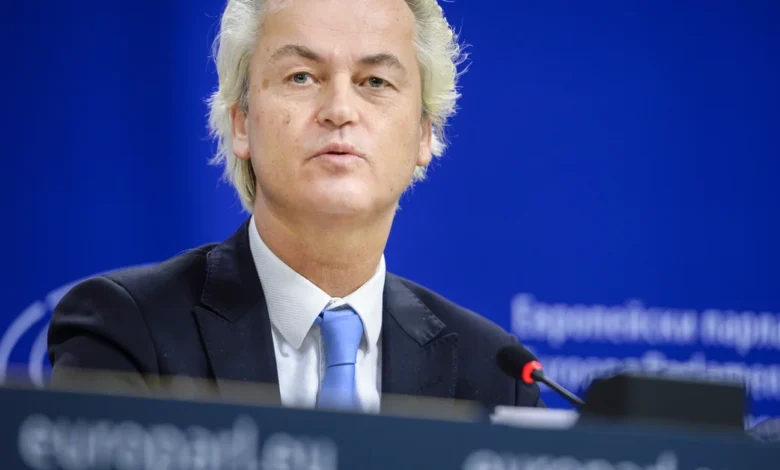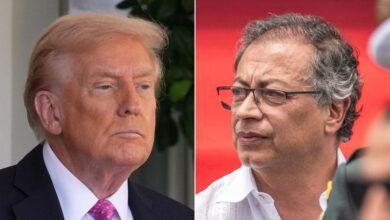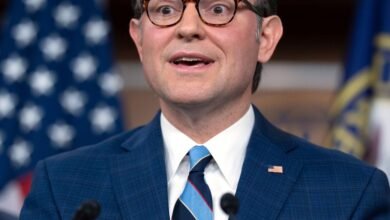Geert Wilders’ Digital Politics | Diggit Magazine

Geert Wilders is one of the most controversial politicians in Dutch politics; yet, his party, the PVV, became the largest in 2023. How does Wilders navigate the world of digital politics?
Who is Geert Wilders?
Geert Wilders is one of the most controversial politicians in current Dutch politics. The 61-year-old far-right politician’s often radical statements and plans have polarised the country. His views on Islam and immigration, to name a few, have led to an abundance of death threats, causing him to live a life under constant protection by security. Wilders is not new to politics. He joined the House of Representatives back in 1998 as a member of VVD, the People’s Party for Freedom and Democracy. Six years later, he left VVD and founded a new party not long after. He called it “Partij voor de Vrijheid” (PVV), which translates to “Party for Freedom” (Tweede Kamer, n.d.).
Although Wilders already required permanent security after his departure from the VVD in 2004, the threats against him would intensify over time. One key moment in this development was the release of his short film “Fitna” in 2008, in which he aimed to “show” the dangers of Islam (Ornstein, 2024). At the start of the film, for example, a verse from the Quran is shown, followed by footage of the September 11 attacks in New York. Additionally, very graphic videos and images of corpses are shown (atcoalition, 2009). Another incident occurred a couple of years later, in 2014, during his infamous speech, where he asked his supporters the following question: “Do you want, in this city and in the Netherlands, more or less Moroccans?” This question was followed by the crowd shouting “Less, less, less…” These are just two examples of Wilders’ Islamophobic, nativist, and populist ideas.
On November 22 2023, millions of people in the Netherlands went to the polling stations to cast their votes for the House of Representatives. After tallying the votes, the far-right PVV won the elections. The party received 37 out of 150 seats in the House of Representatives, an increase of 117,6% compared to their 17 seats in 2021 (NOS, 2023). This marks the first time a far-right party has ever become the largest in the Dutch House of Representatives. Despite the controversy surrounding Wilders, he clearly succeeded, as evidenced by the PVV becoming the largest political party in the Netherlands.
Methodology
When discussing politics, it is important to note that a politician’s message is not just their literal communication and discourse based solely on the words that they utter. Although the content plays a substantial role in analysing politics, we should also expand our view and look at the form and presentation as well. As Lempert and Silverstein (2016, p. 2) argue, Message refers more to the creation of a certain political persona or identity. Politicians achieve this by strategically addressing certain issues in their agenda while avoiding others or even attributing them to their opponents. Thus, without explicitly stating it, a specific persona is created for the politician. Additionally, Lempert and Silverstein (2016, p. 26) further thicken this definition by stating that “Message (…) is multimodal in the sense that it can incorporate all sorts of material, from clothing and staging to gesture and speech.” Looking at Message in this sense, even the most banal, routine practices can be considered as contributing to a politician’s Message. Consider Wilders’ haircut, for example. It might seem insignificant, but are we not able to instantly recognise him because of it?
Politics nowadays can not ignore the digital world. Social media platforms like X and Instagram offer politicians more opportunities to reach people than they would have had by relying solely on traditional media. I use the word “opportunities” here, because it is important to note that online visibility is never guaranteed and should not be taken for granted. We are living in an attention economy where people, businesses, and organisations have to fight for our attention, which has been commodified. There is so much content published online daily, that getting (and, perhaps more importantly, keeping) someone’s attention is a difficult task.
Additionally, there is always a threat of invisibility on social media platforms. According to Bucher (2012, p. 1171), there is “the possibility of constantly disappearing, of not being considered important enough.” To navigate the attention economy and make themselves visible, politicians need to be media literate and have algorithmic knowledge. Visibility is not earned randomly; rather, it is a reward for interaction, inscribed in the algorithmic logic of platforms (Bucher, 2012, p. 1174). Correct use of affordances is closely connected to this. Affordances are “what material artifacts such as media technologies allow people to do” (Bucher & Helmond, 2018, p. 235). A distinction can be made between low-level and high-level affordances. The former are specific buttons, sliders, and features of a platform, while the latter are broader dynamics enabled by technology (Bucher & Helmond, 2018, pp. 239-240). In the case of Geert Wilders, I will focus predominantly on his use of X’s affordances, such as the repost button.
Closely connected to digitalisation is the rise of metapolitics 2.0. The original metapolitics, connected to the New Right movement, is an ideological project with the goal of normalising or hegemonising far-right, traditionalist ideas (Maly, 2019). Digitalisation and web 2.0 technology have changed the way this ideological project is realised, thus giving birth to what Maly (2023, p. 81) calls “metapolitics 2.0.” In the case of metapolitics 2.0, new digital practices are employed to disseminate these far-right ideas, and media literacy and algorithmic knowledge are of great importance. That is because social media are just as important as (if not more important than) traditional mainstream media (Maly, 2023, p. 84).
Populism generally has to do with a distinction between the ‘common people’ and ‘the elite’. A populist, then, claims to articulate the voice of the people with an anti-elite tone. In the post-digital age, however, we need to look beyond just journalists, politicians, and academics. As Maly (2022, p. 43) argues: “the affordances of digital media and the web 2.0 push us toward understanding populism as a digitally mediated and chronotopic communicative relation between different human and algorithmic actors.” This is also known as algorithmic populism. It is essential to keep digital technologies in mind when studying populism, and to recognize that algorithmic populism is understood within a specific time-space context.
To analyze how Wilders navigates the space of digital politics, I followed various of his accounts on social media for about 4 months at the end of 2024. I will use a discourse analysis approach to examine the data. Jones et al. (2015, p. 4) provide a useful framework by stating that discourse analysts usually pay attention to four different dimensions: text, context, action and interaction, and power and ideology. In the following analysis section, these dimensions will be used to help guide the analysis.
Wilders’ Algorithmic Populism
The following section will analyze Wilders’ presence on Twitter in relation to populism as a “digitally mediated and chronotopic communicative relation between different human and algorithmic actors” (Maly, 2022, p. 43). To understand populism in this definition, Maly further states that five factors are of key importance:
- an actor who claims to speak in the name of the people,
- who has some knowledge of the needs of the people,
- who gets labelled as a populist by other actors,
- uses digital media in their populist practices,
- and generates some form of uptake.
Figure 1 shows a post Wilders made on X. In it, he provides a summary of some European governments’ recent decisions regarding immigration and asylum policies. Perhaps to no one’s surprise, these examples are all in line with his views as well. He then proceeds to state that “The voice of the people is heard.” That sentence is a clear signifier of a populist framework. After all, a populist claims to articulate the voice of the people. By mentioning multiple other governments that made decisions similar to Wilders’ plans, he expands that voice internationally. The Dutch ‘voice’ (which in this case disregards more than half of the population, as only around 2.5 million people voted for PVV) is not the only one that wants stricter immigration policies, as this is also happening in other countries,such as Italy and Sweden. Using these examples could very well help strengthen his message and make it more convincing to the people who see the post.
Paying attention to uptake when analyzing contemporary populism is just as important as examining the input (Maly, 2022, p. 54). How is the content received, and what do the numbers say? Examining the numbers in Figure 1 reveals that Wilders’ posts are quite popular. This particular post has been viewed over 600,000 times as of January 2025, and it has garnered an enormous number of likes, retweets, and comments. When it comes to generating uptake, Wilders is no stranger to that. His X account has over 1.5 million followers, and most of his posts easily surpass 100k views. It is safe to say that Wilders has created a strong presence on social media, with his posts standing out among the vast amount of content posted daily on X.

Comments are an important form of engagement, as they provide more context than a simple like or repost. Figure 2 shows a collection of supportive comments under one of Wilders’ posts, with people expressing their love for him. Wilders makes good use of the affordances of X, the repost button in particular, by reposting these comments to his feed. Because of this, they will appear as a separate post on people’s feeds, rather than only being visible when viewing the comments of the specific post they were commented under. By selectively sharing this positive uptake, Wilders enforces the idea that the public loves him.
It seems that Geert Wilders also embraces the populist label. As shown in Figure 3, Wilders reposts a post from Breitbart London, which calls him “Dutch Populist Leader Geert Wilders”. As mentioned above, being labeled as populist by other actors, such as journalists or academics, is a key factor in understanding algorithmic populism.

Considering everything presented above, it is undeniable that Wilders knows how to effectively navigate social media platforms and digital media to achieve his political goals. The fact that politics have changed thanks to digitalization and web 2.0 technologies is something Wilders knows as well. After all, he states: “Long live X! So far, my posts here from the past year have been viewed more than half a billion times, no traditional media can compete with that!” (My translation).This connects nicely to what Maly (2023, p 84) said about social media playing an important role in contemporary politics.

Wilders’ Message Politics
Message, as I described earlier, is multimodal. It looks at more than just literal communication. Other things, such as clothing, speech, and gestures, all help shape a politician’s Message. Instagram is an app with an emphasis on visual content, so I took a screenshot of part of Wilders’ feed to analyze it (Figure 5).

What we see here is that, despite being a politician, Wilders posts many things that are seemingly unrelated to politics (but as I said, even those things can contribute to a politician’s Message). By sharing pictures of his holidays, occasional drinks, and even a picture from his youth, this account often appears to be one made by a regular citizen who is not in politics. In other words, Wilders is just like the common people. Of course, we can not ignore the cat pictures. Wilders appears to be a friendly, empathetic cat lover, although those words may not be the first thing that comes to mind when one hears his name. This persona is further strengthened by the fact that he has an X account specifically for his cats.

Using ethnopoetics, — as described by Blommaert (2018) — to analyze the way Wilders structures some of his discourse reveals some interesting insights as well. Wilders makes use of triplets on multiple occasions in his discourse. In the post in Figure 6, he uses “Onze, Onze, Ons” three times at the beginning of the word groups. The triple repetition of variations of the word “our” places extra emphasis on his nationalistic views. “Our” nation, the Netherlands, is highlighted. Due to the nice poetic structure of his discourse, the message he conveys is affectively appealing and therefore more convincing (Blommaert, 2018, p. 4).
It is important to note that in the digital age, political discourse and messages are not produced solely by politicians (Blommaert, 2019, p. 7; Maly, 2022, p. 44). Anyone online can take a piece of discourse, whether that is an image, text, or video, and repost or edit it. This process is known as entextualisation. As Blommaert (2019, p. 7) defines it:
“Entextualization refers to the process by means of which discourses are successively or simultaneously decontextualized and metadiscursively recontextualized, so that they become a new discourse associated to a new context and accompanied by a particular metadiscourse which provides a sort of ‘preferred reading’ for the discourse.”

During a search on TikTok, I came across an interesting video that perfectly visualises these practices. The account that posted the video is called @pvvnederland, but it is not the official PVV account. On this account, the two primary content types are memes and statistics. The video I want to highlight (Figure 7) features three edited images of quotes or statements from other political parties. Translated:
“No one overboard. Except our principles”
“No idea which party has driven this country into the abyss for the past 13 years, but we will solve it again.”
“Handing out flyers is triggering for victims of papercuts.”
The images are meant to ridicule those parties, which is supported by the caption of the video being “You can’t take these 3 parties seriously, can you? Vote PVV today.” Here we see the original designs of other parties’ campaign posters being entextualised into a meme meant to make fun of them. This is what Lempert and Silverstein (2016, p. 26) refer to as negative messaging: “how you want to brand your opponent.” In this case, people other than the politician are campaigning for PVV by painting others in a negative light. This shows how digital media have made it easier for a party’s ideas to spread. Additionally, these memes are emblematic of metapolitics 2.0, as this type of metapolitics relies heavily on digital practices,such as memes and trolling (Maly, 2023, p. 86).
Far-right Thrives on the Internet
Geert Wilders is a prime example of how politicians utilize digital platforms to convey their message, engage with their audience, and shape their political persona. With his algorithmic knowledge and digital literacy, he uses multiple platforms and their affordances to share his Message and ideas. His algorithmic populism and Message politics show how digital media are crucial in contemporary politics.
References
atcoalition. (2009, March 15). Fitna [Video]. Dailymotion.
Blommaert, J. (2018). Trump’s Tweetopoetics. (Tilburg Papers in Culture Studies; No. 203).
Blommaert, J. (2019). Political discourse in post-digital societies.
Bucher, T. (2012). Want to be on the top? Algorithmic power and the threat of invisibility on Facebook. New media & society, 14(7), 1164-1180.
Bucher, T., & Helmond, A. (2018). The affordances of social media platforms. In J. Burgess, A. Marwick, & T. Poell (Eds.), The SAGE Handbook of Social Media (pp. 233-253). SAGE Publications Ltd.
Jones, R. H., Chik, A., & Hafner, C. A. (2015). Discourse analysis and digital practices. In R. H. Jones, A. Chik, & C. A. Hafner (Eds.), Discourse and digital practices: Doing discourse analysis in the digital age, 1-17. Routledge.
Lempert, M., & Silverstein, M. (2012). Creatures of politics: Media, message, and the American presidency. Indiana University Press.
Maly, I. (2019, March 15). White terrorism, white genocide and metapolitics 2.0. Diggit Magazine.
Maly, I. (2022). Populism as a Mediatized Communicative Relation: The Birth of Algorithmic Populism. In C.W. Chun (Ed.). Applied Linguistics and Politics (pp. 33–58). London: Bloomsbury Academic.
Maly, I. (2023). Metapolitics, Algorithms and Violence: New Right Activism and Terrorism in the Attention Economy. Taylor & Francis.
NOS. (2023). Uitslagen Tweede Kamer 2023. Retrieved January 4, 2024.
Ornstein, L. (2024, October 7). Wat is de PVV? NPO Kennis.
PVV. [@pvvnederland]. (2023, November 22). Deze 3 partijen kun je toch niet serieus nemen. Stem vandaag PVV. #fy #fyp #geertwilders #verkiezingen #pvv #politiek #wilders #partijvoordevrijheid.
Tweede Kamer. (n.d.). Geert Wilders. Retrieved January 4, 2024.
Wilders, G. [@geertwilders]. (n.d.). Posts [Instagram profile]. Instagram.
Wilders, G. [@geertwilderspvv]. (n.d.). Posts [X profile]. X.
Credit: Source link






